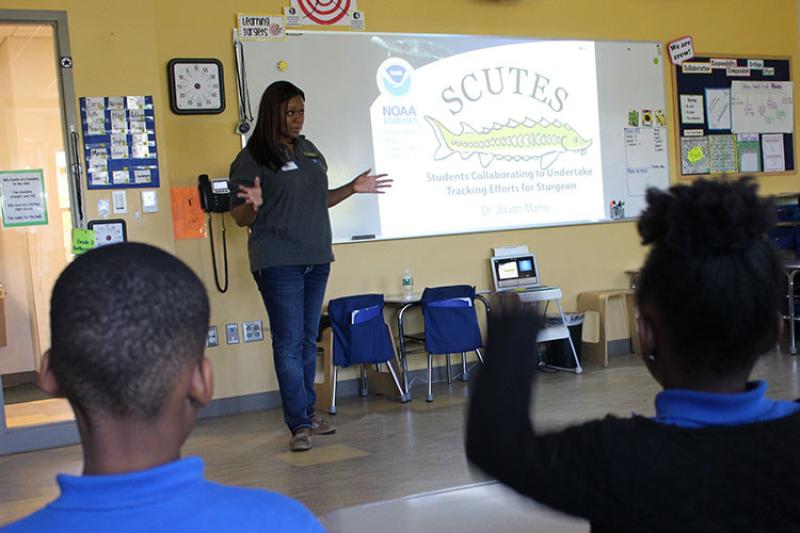At least once a year, someone reports a strange “sea monster” washed up on an East Coast beach or riverbank. Often, these “monsters” are actually Atlantic sturgeon, prehistoric-looking fish that can grow to be 14 feet long and weigh 800 pounds. Instead of scales, these fish have five rows of bony “scutes” or modified diamond-shaped armored scales, along the length of their bodies. These primitive fish were alive during the Cretaceous period, alongside dinosaurs.
Jolvan Morris coordinates our Students Collaborating to Undertake Tracking Efforts for Sturgeon, a sturgeon outreach program that takes its acronym from the sturgeon’s bony plates. The SCUTES program is a collaboration between NOAA Fisheries, sturgeon researchers, teachers, and informal educators to bring more awareness about sturgeon and the Endangered Species Act into schools and classrooms.

Part of this curriculum includes a SCUTES Adopt-A-Sturgeon program in which students "adopt" and track specific fish. Tracking a fish is not as easy as it sounds—researchers have to catch fish and insert tracking tags under the fatty skin layer of the fish. Then, as the fish swims near one of the acoustic receivers, the receiver records the number, date, and time the fish swam by. These acoustic receivers are about the size of a 1-liter bottle. They are deployed up and down the coast in coastal waters as well as in rivers and estuaries. Researchers go to their receivers periodically and download all of the data. They can have thousands of data points for several different fish. It can take a long time for busy researchers to find 10 to 20 data points that really capture the "adopted" sturgeon’s migration. Jolvan notes that getting up-to-date migration tracking data from the scientists to share with students can take some time, but it’s always worth the wait.
To get to where she is today, Jolvan interned twice in our Protected Resources Division, while she was in graduate school and then again afterwards. As the SCUTES program was being developed, she compiled information for teachers as they designed sturgeon-centric lesson plans for SCUTES and also created some activities herself. Jolvan earned a Ph.D. in Environmental Science at Florida A&M University. Six years after her second internship, she was hired as our permanent SCUTES Coordinator.
“It’s been awesome to see how the program has evolved since being and intern and since Atlantic sturgeon were listed under the Endangered Species Act.”
In her spare time, you can see Jolvan riding her Harley Davidson motorcycle named Louisa, after her home state of Louisiana.
To contact Jolvan, email jolvan.morris@noaa.gov or call her at (978) 281-9429. Learn more about the SCUTES Curriculum



